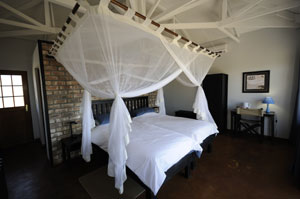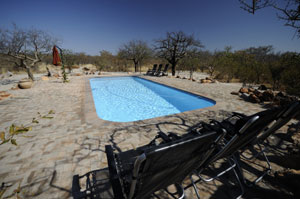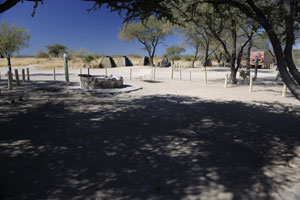| 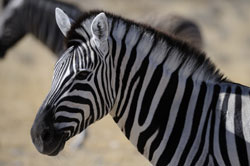 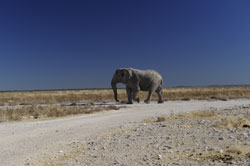 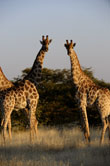
Etosha National Park is one of Southern Africa's
finest and most important Game Reserves. Etosha Game park was declared
a National Park in 1907 and covering an area of 22 270 square km,
it is home to 114 mammal species, 340 bird species, 110 reptile
species, 16 amphibian species
Etosha, meaning "Great White Place", is dominated by a
huge mineral pan roughly 130 km long and as wide as 50 km in places.
The salt pan is part of the Kalahari Basin, the floor of which was
formed around 1000 million years ago. The Etosha Pan covers around
a quarter of the National Park.
The pan was originally a lake fed by the Kunene River. However the
course of the river changed thousands of years ago and the lake
dried up. The pan now is a large dusty depression of salt and dusty
clay which fills only if the rains are heavy and even then only
holds water for a short time.
This temporary water in the Etosha Pan attracts thousands of wading
birds including impressive flocks of flamingos.
The game viewing in Etosha National Park is excellent,
the best time being from May to September - the cooler months in
Namibia. Visitors to Etosha Game Reserve can expect to see many
antelope species, elephant, giraffe, rhino and lions. More fortunate
visitors will see leopard and cheetah.
There is a network of roads linking the three campsites and subsidiary
roads lead to various waterholes.
The Etosha Park is one of the first places on any holiday itinerary
in Namibia.
Visitors to Etosha have a choice of three rest
camps and one luxury lodge inside the park: Namutoni,
Halali,
Okaukuejo
and Onkoshi.
All three restcamps camps have floodlit waterholes, two of which
provide excellent night game viewing.
Rhino and elephant are often seen at the waterhole at Okaukuejo,
while the waterhole at Halali is fast attracting more wildlife.
However, Namutoni waterhole can be disappointing because there are
so many other waterholes in the vicinity.
Each camp has tourist facilities such as a restaurant, a shop (selling
only basic goods), a motor garage for fuel and basic repairs, and
a swimming pool, as well as various grades of accommodation and
camping facilities.
Visitors to Etosha, can stop off at these camps for rest, recreation,
and refueling.
Onkoshi Camp opened in September 2008 inside Etosha - this is
the first development inside the park in several decades and offers
an environmentally friendly luxury experience.
There is also accommodation
around Etosha Park including: camping,
lodges,
tented camps
and self catering.
Visitors should note that the park is only open from sunrise to
sunset. Outside of these hours, visitors either have to be in one
of the camps, or completely outside the park.
Map of Etosha Park
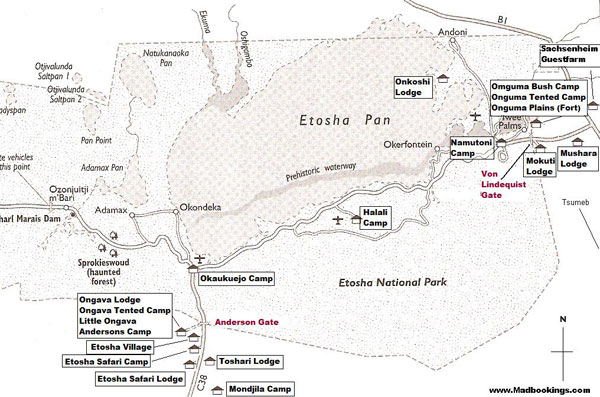
The main entrance to the park is called the "Andersson
Gate" situated near Okaukuejo in the south. The eastern entrance
is called the "Von Lindequist Gate" and is near Namutoni.
The new "Nehale lya Mpingana Gate" gate, (King Nehale
Gate) was opened at the beginning of 2003 in the north-east.
Facilities in Etosha Park


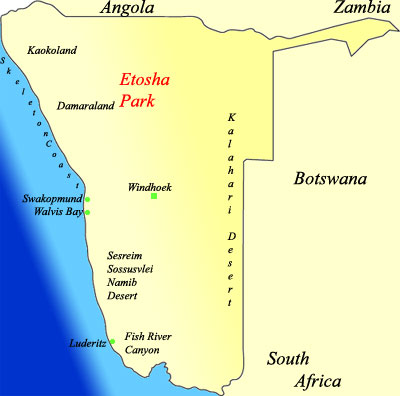 Distances
from Etosha Distances
from Etosha
(Anderson Gate) to
Windhoek
Sesreim
Swakopmund
Fish River Canyon
Luderitz
Borders to Etosha (Anderson Gate)
Ariamsvlei - SA
Noordoewer - SA
Velloorsdrift - SA
Buitepos - Botswana
Ngoma - Botswana
Wanela - Zambia
Kazangula - Zambia
History of Etosha
When it was originally proclaimed at the turn of the century the
Etosha Park consisted of an area of 100,000 square kilometres. This
was the largest reserve on earth but in the 1960's political pressure
resulted in the Park being reduced to its current size.
Etosha was first established in 1907, when Namibia was a German
colony known as South West Africa. At the time, the park’s
original 100,000 km² (38,500 mile²) made it the largest
game reserve in the world. Due to political changes since its original
establishment, the park is now slightly less than a quarter of its
original area, but still remains a very large and significant area
in which wildlife is protected.
The Etosha Pan was one of several sites throughout southern Africa
in the Southern African Regional Science Initiative (SAFARI 2000).
Using satellites, aircraft, and ground-based data from sites such
as Etosha, partners in this program collected a wide variety of
data on aerosols, land cover, and other characteristics of the land
and atmosphere to study and understand the interactions between
people and the natural environment.
Accommodation in and around Etosha Park
|






 Distances
from Etosha
Distances
from Etosha 